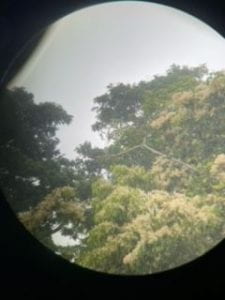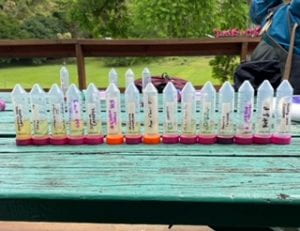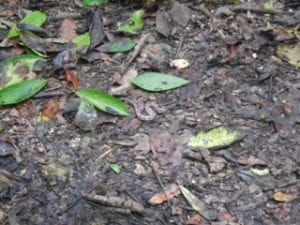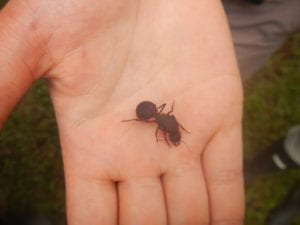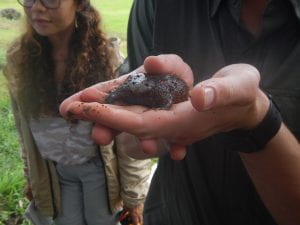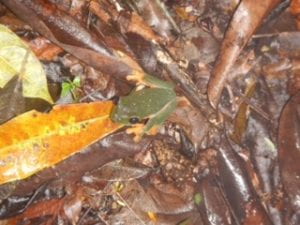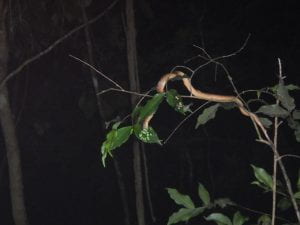Day 2 in the rainforest started off early with a lot of sightings during the morning birdwatch. I saw two crimson-collared tanagers, which are black with a red head and rump, as well as a black mask. I also say a blue-gray tanager, which is a bit smaller and flies by sporadically flitting its wings. One bird that I had to research in my field guide to identify was a white-collared seedeater! This bird was small (like the size of a finch), had a black head, light-colored wingbar(s), brown/white patchy body, and a white band laterally around its throat. I spotted it in the grass, which makes sense if it was foraging for seeds. I also saw a pale-billed woodpecker, which is a very large woodpecker with a black body, bright red head, and a white line down both sides of its neck that meets on its back. One bird that I managed to get a photo of was a social flycatcher! It was brown with a yellow breast and belly. Its white head had a black eyeline and crown, and its wings had a light wingbar.
Then, we started another experiment testing the nutrient attraction of arthropods and their abundance on the forest ground versus the forest canopy. We chose methodology to place pitfall traps of both water and a nutrient solution to test our question. The nutrient solution that was the most widely available was our own urine, so we all peed in tubes. We ranked our pee in hydration by comparing color. A huge shoutout to Rusty for having crystal clear pee and being my TFB hydration idol. Then, we put our water and pee tubes on the floor and hung them on trees!
Right by my pitfall tree, we spotted a jumping pit viper! Luckily, Phoenix saw it before anyone got too close, so we were all safe.
We also saw an eyelash viper curled on a nearby log! Rafael, the LCRS station manager, said that he had never seen an eyelash viper in all his 12 years here, so we were super lucky to see one! I didn’t get a photo, but a lot of my classmates did.
We also did a leafcutter ant activity where we dug up their nests. We started with a 1-year-old nest, and we took turns digging with a shovel. We found the fungal gardens, and it looked like spongy, white honeycomb. After some more digging, Scott uncovered the queen! She was huge and was being protected by smaller ants, but she didn’t try to bite anyone. I got to hold her! I feel so lucky to have met the queen.
We moved onto another bigger nest, but there were too many rocks and roots to dig it up. Right when we were about to find another nest, Michael shoveled one last scoop and initiated another lucky find! Sitting in the mound was a Mexican burrowing toad! This toad is black with orange markings and very round in shape. Its head is very small and is basically missing a neck. When Rusty gave his amphibian taxon briefing last night, he said that he really wanted to find one of these toads. So another shoutout to Rusty for his toad-finding dreams coming true, I’m so happy for him!
I gave my topic lecture on neotropical plant-insect interactions, and I think it went really well!
After sunset, we went on a night hike! Before leaving, I spotted a red-rumped tarantula on the deck! It crawled out of a space between some of the wooden planks.
Then on the actual night hike, We had so many amazing sightings! We saw two Morelet’s tree frogs, as well as their eggs. It is extremely rare to spot Morelet’s tree frogs because they are critically endangered, so we were really lucky to see them! Then we spotted small snakes on the tree branches above us. We witnessed one snake eat tree frog eggs!
The theme of today seemed to be pure luck, and I feel so fortunate to have experienced it all. Maybe tomorrow Ava will catch a blue morpho butterfly!
– McKenna

